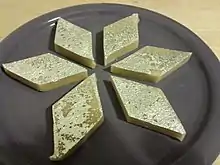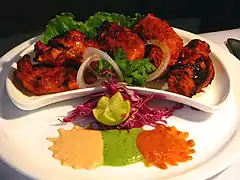Kaju katli
Kaju katli (literally "cashew slice"), also known as kaju barfi, is an Indian dessert, originating in the Deccan region of Southern India,[1] similar to a Barfi. Kaju means cashew; barfi is often made by thickening milk with sugar and other ingredients (such as dry fruits and mild spices). Kesar kaju katli includes saffron.
 Kaju Katli | |
| Alternative names | Kaju Katri, Kaju Barfi |
|---|---|
| Course | Dessert |
| Place of origin | India |
| Region or state | Deccan[1] |
| Associated cuisine | Indian |
| Created by | Bhimrao |
| Main ingredients | Cashew nuts, sugar, ghee |
| Variations | Kesri pedha, barfi, pista barfi |
| 41 kcal (172 kJ) | |
The dish is prepared with cashew nuts soaked in water for a considerable period of time (usually overnight), which are then ground to a paste. Sugar solution is boiled down until a single thread forms when two fingers are dipped into it and pulled apart, after which it is added to the ground cashews. Ghee, saffron (kesar), and dried fruits may also be added.[2] The paste is then spread and flattened in a shallow, flat-bottomed dish and cut into bite-sized rhombus-shaped pieces. The pieces are usually decorated with edible silver foil. The finished sweet is usually white or yellow in color depending on the ingredients used for the paste and the proportions of each used. Kaju Katli is traditionally eaten during the Hindu festival of Diwali.[3]
History and cultural significance
Kaju Katli or Kaju Barfi has a long history in India, originating in the Deccan region of Southern India.[1] It has now spread throughout the country[1] and became a beloved sweet across the country. Kaju Katli is said to have been invented in the 16th century by a famous chef named Bhimrao, who worked for the royal family of the Maratha Empire. The Marathas were known for their love of sweets, and Bhimrao was tasked with creating a new dessert that would impress the royal family.
According to legend, Bhimrao was inspired by a Persian sweet called “Halwa-e-Farsi,” which was made with ground almonds and sugar. He decided to create his own version using cashews, which were abundantly available in the region.
Bhimrao’s creation was an instant hit with the Maratha royals, who named the sweet “Kaju Katli” in honor of its two primary ingredients – “Kaju” meaning cashews and “Katli” meaning thin slices.
Over time, Kaju Katli became a popular sweet not just in Maharashtra, but in other parts of India as well. It is now considered to be one of the most iconic Indian sweets and is an essential part of every celebration, from weddings to festivals.
References
- Sharma, Gunjan (26 October 2019). "Sweet Corner: Delhi's Kaju Katli". The Times of India. Archived from the original on 25 October 2019. Retrieved 20 October 2023.
The sweet is said to have originated in the Deccan and then became popular in north India
- Bladholm, Linda (12 August 2000). The Indian grocery store demystified. p. 175. ISBN 1580631436.
- Kapoor, Sanjeev. Sweet Temptations. Popular Prakashan. ISBN 8179915700.


